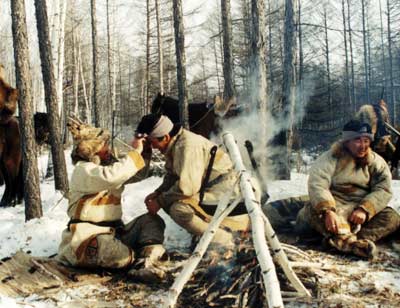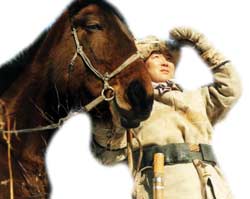| Last of the Hunters |
| http://www.sina.com.cn 2005/03/22 18:13 thats China |
 Oroqen resting on their way to a hunt By hiding out in the woods, the Oroqen have survived the upheavals of history By Yap Su-Yin It wasn't until 1952, when China erected permanent housing for the final 300 families, that the Oroqen "settled down." The people of this autonomous banner learned to grow crops from the Daur minority, and by 1975, the formerly nomadic people had self-supporting stores of grain for the first time in their history. Today they boast factories and workshops churning out farm equipment, furniture, leather and fur. Schools have sprung up offering primary and secondary schooling. In 1992, the Oroqen gained a writing system; developed by a teacher, Zhang Yuhua, the language uses phonemes from the Oroqen verbal language. Oroqen culture has retained the strength to endure constant interference since the Qing Dynasty (1644 - 1911). With the arrival of guns and iron, individual families started to own more things, and in turn bartered these for other commodities. Some families became better off than others. The characteristic communal sharing of the Oroqen people started to disintegrate as individual families became basic economic units and quit the commune. Under the Qing Dynasty's "Eight Banner system," the Oroqens were drafted into military service and died in wars in Xinjiang, Yunnan and Taiwan. Over the next few centuries, Oroqen hunters continued to be pulled into one military foray or another. After the Qing fell and warlords reigned, Oroqen hunters who did not escape back into the forests were forced to settle down and farm.
Perhaps worst of all for the Oroqen was when Japanese troops occupied northeast China in 1931, destroying property and farms belonging to Oroqen farmers, who fled back to the forests. Subsequent repression and the onslaught of epidemic diseases decimated the Oroqen population. When the Japanese surrendered in 1945, only some 1,000 Oroqen remained. Numbering 7,000 today, the Oroqen are the third-smallest of China's 55 ethnic minorities. The name "Oroqen" was given to this ethnic group after the founding of the People's Republic of China in 1949. Most live in the 55,000-square-kilometer Oroqen Autonomous Banner, a forested area in the Greater Hinggan Mountains of Inner Mongolia. In its capital Alihe, the physical trappings of modernity - department stores, restaurants, hotels and electricity - belie the cultural uniqueness of the Oroqen people. Erba, an Oroqen elder, can point to the birch tree on his daily trek that may one day be his final resting place. The trunk of this tree will be hollowed out when he dies, so that his body, curled like a baby in a cradle, will rest there for good if the tradition of his forefathers is respected. Home for Erba is a humble hut in Heilongjiang Province, where his family of eight live in a commune of some 300 villagers. Erba's ancestors came from one of seven tribes originating from the areas north of Heilongjiang and south of the Outer Hinggan Mountains. Aggression by seventeenth- century Tsarist Russia drove them to relocate where they are today. Called "Suolunbu," "Dashengbu" and "Shilubu" at the time, the tribes were organized into clans. Each clan, or wulileng, comprised up to a dozen families descended from the same male ancestor. Traditionally nomadic, both men and women had for generations put food on the table through superb marksmanship. The children - boys especially - started to hunt at 7, accompanied by older family members. By 17, they were full-fledged solo hunters. They hunted on horseback, fished and shared the catch of the day with everyone in their commune. Their staple food was meat from deer, moose and wild boar. If a bear was killed, its bones were strung high in the trees near their homes for safekeeping. Offerings were made to the soul of the dead bear. The bear and tiger are revered as "grandfather'' and "long tail" respectively. Animal pelts became tents, blankets, gloves, socks and hats, on which the women stitched pictures of deer hunts and nature. Bark from birch trees was transformed into basins, bowls and boxes. Mainly animists or shamanists who worshipped nature and ancestral spirits, the Oroqen put items of worship, such as the bones of a dead bear wrapped in straw, in their birch-bark coffins. Home was a conical structure, made from some 20-30 wooden poles gleaned from the surrounding pine or birch forests. Their former abodes were called xierenzhu in Han language, meaning "house borne by wooden poles". Although family size affected tent size, it was usually small: 5 meters in height, six meters across. What was used to cover the exterior depended on the season - stitched birch bark in summer; the skin of wild doe in winter. The opening usually faced to the east or south. A fire-space occupied the center. A hole directly above allowed smoke from cooked food to escape and let in sunlight. Traditional custom prohibited the expectant mother from delivering at home. Instead, she delivered in a hut outside the home. Built especially for that purpose, the hut was where a mother convalesced for a month before moving back into the house with her newborn. Oroqen oral history is peppered with hunting tales, legends and folktales. Passed through the generations, these are animated with song and dance. The Oroqen use hand-made percussion and wind instruments, including, for instance, a kind of harmonica called the pengnuhua and a hand-drum called a wentuwen. They also make instruments to produce tunes that mimic the twitter of birds or the braying of deer to lure wild beasts. In some dances - the more popular being the "Black Bears Fight" and "Wood Cock Dance'' - they move like the bear or fowl. The entire clan joins in the telling by singing, dancing or making music. |
|
|
|
|
|
| Annotation |
| 新 闻 查 询 |
| 热 点 专 题 | ||||
| ||||
|
教育频道意见反馈留言板 电话:010-82628888-5747 欢迎批评指正
新浪简介 | About Sina | 广告服务 | 联系我们 | 招聘信息 | 网站律师 | SINA English | 会员注册 | 产品答疑
Copyright © 1996 - 2005 SINA Inc. All Rights Reserved
版权所有 新浪网![]() 北京市通信公司提供网络带宽
北京市通信公司提供网络带宽
